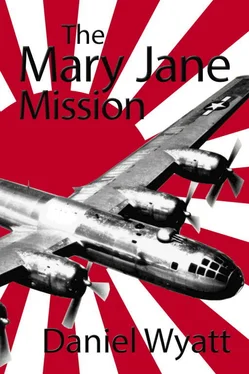In the process of making more calculations, the navigator was careful to differentiate between the True Air Speed (TAS) and Ground Speed (GS). He read the TAS off the airspeed indicator. The GS he calculated by pinning down his location, then dividing by time. He determined that in the last thirty minutes the B-29 had flown exactly 102.5 nautical miles.
Satisfied, he inserted the information in his log.
Time : 0202 local
Position : 14 miles NW Asuncion
True Course: 341
Drift Correction: +7
True Heading: 348
Variation: +1
Magnetic Heading: 349
Deviation: -
Compass Heading: 349
Temperature: +21
Altitude : 3000 feet
TAS : 216 knots
GS : 205 knots
Distance to Iwo Jima: 406 miles
Time : 0158
ETA : 0402
* * *
USS MIDWAY
Carrier landings were always tricky business. Les knew it. He had never liked night landings, although he did consider them a worthy challenge, like pricking an Arizona rattler’s tail. What was to enjoy in landing on a dark, pitching flat-top, often in windy and rainy conditions? It was enough to make at least a few aviators pack in the navy for good. Tonight, however, a full moon would make it a notch easier. Moonlight helped to ascertain the horizon, that sometimes unidentifiable separation between sea and sky. Les remembered two pilots in the last few years who had quit because of treacherous recoveries. This would be his hundred and thirtieth landing. Or trap, as they called it. He was hoping for an OK mark from the LSO — the Landing Signals Officer — who stood to the port side of the deck, directing the incoming pilots. The grade, whatever it would be, would be displayed next to his name on the ready room chart. OK was equal to an A-plus. He didn’t want anything to do with the inferior marks of Fair (not that good but safe), No Grade (dangerous for the pilot, crew, and carrier), and Cut (lousy, unsafe, could have resulted or did result in a serious accident).
Les switched the Hornet to the ACLS, the Automatic Carrier Landing System, also known as Mode One. He was over nine miles from the ship. The onboard computer would now take over and bring the fighter in at a sink rate of 600 feet per minute on a “hands-off” approach.
“DEAD CENTER ON THE GLIDEPATH, ZULU TWO-FOUR-THREE. BRING HER IN,” the approach controller said over the radio.
Les took over the controls at one mile and continued to bring the Hornet down, coming in at a four-degree glidescope. The visibility over the nose and the angle of attack in a Hornet was excellent. Every little bit helped in a carrier landing.
Midway ’s deck, only 600 feet away, was unlit except for a series of lights along the edges and down the center line. The strategy on carriers in general was to aim the fighter’s arrester hook at the third wire. Too low and Hulk would bang into the stern. Too far left or right and he’d hit parked aircraft. Too high and he’d have to settle for a “bolter,” or go-around. Landing on Midway was especially tough because she had only three wires, as opposed to the bigger flat-tops, which contained six. In case he was forced to try again, he was coming in at standard procedure for navy pilots — full military power and full flaps. Minutes before, Hulk had been ordered to dump several thousand pounds of fuel into the ocean to lighten the load and make for an easier touch down.
Les picked up the orange ball on the landing sight, to the deck’s port side. The green optical lights on the Fresnel lenses were in line. He had the right altitude and his wings were level. The deck raced towards him. Then he felt a solid thunk and a quick jolt to the body.
The wire caught.
He made it. Number 130. The hook runner sprinted up to the fighter and with a hand motion let the deck operator know that the fighter was OK to pull backwards to disengage the tail hook. Les knew how rough the hook runner’s job was. It was only one year earlier on the same carrier that Les had seen an F-18 break loose from the arresting wire upon landing. The wire had cut the legs off the hook runner. The pilot had been so shaken he quit the navy.
When he climbed down the retractable boarding ladder, Les saw the silhouette of Tiger’s Hornet, several hundred feet out, halfway on the downwind path. He noted wind gusts across the deck. The green-coated ground crew quickly pulled Les’s fighter away to one side. From behind the barricade below the superstructure, he turned to watch Runsted on final.
“You’re too high, you dope,” Les said to himself, as his eyes went from the landings lights to Runsted’s fighter, coming in full power. “You’re too high.”
Then as Tiger neared the deck, he lit the afterburners and pulled the Hornet’s nose up. Over the sea, he banked to port. Les shook his head. Try again, pal.
* * *
The two pilots met a short time later by Runsted’s recovered Hornet, just as the deck crew circled it.
“I couldn’t control her.”
“Crosswind?” Les asked.
“Yeah.” Runsted frowned as he rested his hand on the nose of the F-18. Then, something caught his attention. A hole in the metal. He stuck a finger through it. “Geez, will you look at that,” he said, frustration in his voice.
“That’s a bullet hole,” Les responded.
“Yeah, fifty caliber.”
The two checked the aircraft over for other holes. None. The crew hooked the fighter up and towed it away, as the pilots stood there.
“What are we going to tell the captain, Hulk?”
“Simple,” Les replied quickly. “We’ll just tell him… a B-29 shot at us.”
“Sure. Hell, yeah. Why not?”
* * *
GUAM
Captain MacDonald arrived in his Agana, Guam office before sunup to examine the infrared photo-reconnaissance pictures. He swiftly closed the door behind him, then flicked on the deck lamp before he sat down. He carefully opened the sealed envelope and laid the eight-by-ten photos on his desk.
He grunted aloud.
So… damn … it was the B-29. Is this what he was woken for at four in the morning? However, his irritation vanished once he took a second look. This was really strange. The bomber’s markings weren’t Fifi ’s.
What the hell?
TINIAN ISLAND
Robert and Edna Shilling checked into the busy lobby at the Fleming Hotel, in the village of San Jose. There they received their reunion paraphernalia consisting of name tags, brochures on the 509th Composite Group and information on the island as it was today. And, of course, a room key.
Looking around the lobby and recognizing a few people, even remembering some names, Robert suggested that they drop the bags in the room and come back down.
They just got inside the room when the phone rang. Robert sat on the bed and went for the receiver.
“Dad, it’s Les.”
Robert broke into a smile, glancing up at Edna. “Hi, son.”
“Sorry I missed you at the airport. I hope Gail took care of you.”
“She did. No problem. Don’t you have the perfect timing.”
“How’s that?”
“We just got into our room. So I heard you were on some exercise out to sea.”
Les chuckled. “Talk about timing, huh. So, when will I see yuh?”
“We’ll be back on Guam in — let’s see — four days. Saturday morning. Arriving at nine.”
“Right. We’ll save the talk for the weekend, OK?”
“OK, son.”
“See you Saturday. Have a good time. Can you put mom on?”
“You bet.”
* * *
While his wife took a shower, Robert pinched his name tag to his shirt and went downstairs to the cocktail lounge. About thirty people were casually milling about. At the bar, he took the last seat, and ordered a scotch and soda. Feeling a tap on the shoulder, he turned around quickly.
Читать дальше












